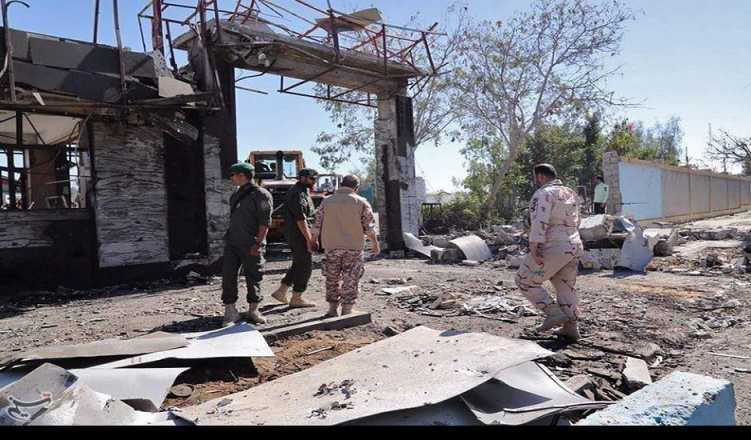The terrorist attack at Chabahar port on Dec. 6 is a disturbing breach for Iran, a country where internal security is ruthlessly protected to prevent a repeat of the conditions that led to government collapse in 1979. This is the second major terrorist attack since the September ambush of a military parade in oil-rich Ahvaz province, and the third major incident since the June 2017 attacks on the parliament and a mausoleum complex in capital Tehran.
To get an idea of the challenge facing Iranian law enforcement, the latest attack occurred as IRGC Ground Force Commander Brigadier General Mohammad Pakpour visited Chabaharunder a security blanket. This is a small town of roughly 110,000 people and a breach of this sort is an affront to the paramilitary force that answers directly to the Supreme Leader and surpasses the professional Iranian armed forces in equipment and resources.
Aside from the security ring for the visiting IRGC general, Chabahar has strong security round the year for the joint India-Iran strategic port project. This security tier was also breached in this attack. No wonder the Indian External Affairs Ministry reacted in panic: “The perpetrators behind this dastardly attack should be brought to justice expeditiously. There can be no justification for any act of terror.”
The significance of this attack is linked to the grand strategic vision behind the Chabahar port project. The stated aim of this project is to facilitate trade between India and Afghanistan. It is poised to shift Afghan trade away from traditional routes through Pakistan. It will also neutralize Islamabad’s geographic advantage for India-Central Asia trade. And the third purpose of this port is to allow India to counter China, which is building the Gwadar deep-sea port in next-door Pakistan. These grand plans depend on a secure and stable environment in Chabahar, a small town in a part of Iran beset for years by ethnic and religious conflict.
India-linked accounts and online troll factories sprang into action immediately after the attack to suggest, in posts and online comments, a Pakistani involvement. These troll accounts appeared to use this incident to harm Pak-Iran relations, which improved in recent months. The Pakistani Ministry of Foreign Affairs was quick to react: “Pakistan strongly condemns terrorist car bomb attack in Chabahar in brotherly neighboring Iran.”
Conspiracy theories aside, Indian interests in Chabahar were not even targeted in this attack, thereby removing any Pakistani interest. A heavily fortified police center was the target. The terrorist group claiming responsibility is also well known in the area. In a statement, it said: “The Iranian Ansar al-Fuqran Group declares that it has taken to a military action through its warriors as a result of the lack of opportunity for civic activity.”
Does this group have foreign support? Iranian commentators have different theories. A study of Iranian official statements since the year 2000 shows that over the years Tehran has changed the countries it blames for terror attacks.
Of course, Iran has not been a victim of terrorism like other countries in the region. But when it did face terror attacks, the official list of possible perpetrators changed according to regional circumstance. When Jundullah, a terrorist group, started its rebellion in 2000, Iranian officials accused the United States, Britain and Israel of training them. In 2017, Iranian military officials also cited Pakistan, mainly because southwestern Iran adjoins wild Pakistani and Afghan territories where criminal activity involving armed groups and drug and human smuggling abounds.
Interestingly, in the most recent attacks, in Ahvaz in September and now in Chabahar, there is no mention of the US, Britain, Israel or Pakistan. In his tweet, Foreign Minister Javad Zarif seemed to be pointing the finger at the UAE. Media outlets linked to IRGC singled out Saudi Arabia. Israel is no longer in the list due to the situation in Syria and reports that Moscow has brokered an indirect truce of some sort between Iran and Israel. And Iranian statements mentioning America are calibrated because of background efforts by Iran’s European and Indian friends to diffuse tensions with Washington.
However, absent any evidence of foreign involvement, these terror attacks appear to be homegrown, involving internal dynamics of Iranian politics. Traditionally, the clerics-led government of Iran post-1979 faced armed insurgencies involving Kurdish, Arab and Baloch groups, involving ethnic and religious grievances.
The strongest and the bloodiest of these groups were Kurdish. Iranian authorities call them “counter-revolutionary” groups, traced to northeastern Iraq and northwestern Iran. The Kurdistan Democratic Party of Iran and the Party of Free Life of Kurdistan are often cited in this regard. The brazen attack on the parliament and the mausoleum of Imam Khomeini, the founder of the Islamic Republic, in June 2017, was thought to be the work of either Kurdish or Islamic State fighters.
In Chabahar, it has more to do with ethnic and sectarian sentiments. For example, Iranian journalist Raman Ghavami said in an analytical thread on Chabahar attack on Twitter that Ansar Al-Furqan was an Iranian group created by IRGC to fight Baloch separatists that later went rogue.
He wrote, “Four years after its establishment by the IRGC, AnsarAl-Furqan’s significant part led by Jalil Qanbarzehi rejected working for Iran. However, this wasn’t accepted by the IRGC and an operation was conducted in June 2017 to destroy the group.”
The IRGC triumphantly declared, in June 2017, that has completely destroyed Ansar Al-Furqan, only to see it resurrected in December 2018.
More interestingly, Ghavami claims the group is ideologically closer to Muslim Brotherhood and Taliban, with links to Brotherhood elements in Turkey, Qatar and Egypt.














